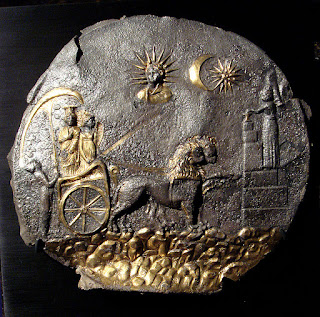For we wrestle not against flesh and blood, but against principalities, against powers, against the rulers of the darkness of this world, against spiritual wickedness in high places....And changed the glory of the uncorruptible God into an image made like to corruptible man, and to birds, and fourfooted beasts, and creeping things.
Ephesians 6:12 /Romans 1:23
"Greek rites and processions show her as an essentially foreign, exotic mystery-goddess who arrives --in a lion-drawn chariot
to the accompaniment of
--wild music,
--wine,
--and a disorderly, ecstatic following.
Uniquely in Greek religion,
--she had a eunuch mendicant priesthood.
An additional explanation for the importation of Magna Mater is the underlying societal anxiety caused by mass lead poisoning. Lead poisoning brought about a whole host of reproductive complications in men and especially women, including sterility, miscarriage, stillbirth, and high rates of child mortality. Elite Ancient Romans were primarily exposed to lead through their drinking habits, since Romans used lead acetate as a sugar substitute to sweeten their wine. Additionally, Ancient Roman medicines often involved boiling together lead powder with other substances like honey or myrrh. Interestingly, Pliny the Elder details that a honey and merum mixture acts as a laxative when consumed cold but blocks diarrhea when consumed hot. This physiological observation betrays the presence of lead, as the toxin has different properties when heated or cooled.
Another source of lead poisoning in Ancient Rome was leaded paint. Elite Romans harbored an appreciation for Tyrian purple and deep Phrygian reds. Thus, when they wished to adorn their villa walls with these exotic colors, lead-based pigments were required.
Vitruvius, a 1st-century B.C. architect and civil engineer, noted the potential dangers of lead pipes in his writings on architecture:
Water conducted through earthen pipes is more wholesome than that through lead; indeed that conveyed in lead must be injurious, because from it white lead is obtained, and this is said to be injurious to the human system. Hence, if what is generated from it is pernicious, there can be no doubt that itself cannot be a wholesome body. This may be verified by observing the workers in lead, who are of a pallid color; for in casting lead, the fumes from it fixing on the different members, and daily burning them, destroy the vigor of the blood; water should therefore on no account be conducted in leaden pipes if we are desirous that it should be wholesome.
The priests of the cult of Cybele were male eunuchs. They would castrate themselves in the midst of sexual pleasure as a means of symbolically offering up their own fertility to the mother goddess.The central rite of these eunuch priests was the taurobolium, first recorded in Pergamum in 105 A.D.
As told by Prudentius in the 4th-century A.D., the taurobolium involved the digging of a trench and placing of a grate on top. Then, a eunuch priest would enter into the pit in the ground. Shortly after, a bull would be sacrificed on top of this trench, allowing all of the animal’s viscera to flow onto the priest.
After the priest had been fully enveloped by every drop of bull blood — “till he drains the deep dark blood with every pore” — the genitals of the bull are cut off and also ceremoniously thrown into the pit.
Such descriptions show how these ceremonies had close thematic links to birth. After being baptized by blood, initiated priests would often drink the milk of the animal, simulating having just been born.
The Megalesia commenced on April 4, the anniversary of Cybele'sarrival in Rome. The festival structure is unclear, but it included ludi scaenici (plays and other entertainments based on religious themes), probably performed on the deeply stepped approach to her temple; some of the plays were commissioned from well-known playwrights.
On April 10, her image was taken in public procession to the Circus Maximus, and chariot races were held there in her honor. The racetrack could be seen from her temple's threshold, and a statue of Magna Mater was permanently sited on the racetrack's dividing barrier, showing the goddess seated on a lion's back: the goddess could thus watch the festivities held in her honor.
--Lucretius vividly describes the procession's armed "war dancers" in their three-plumed helmets, clashing their shields together, bronze on bronze, "delighted by blood"; yellow-robed, long-haired, perfumed Galli waving their knives, wild music of thrumming tympanons and shrill flutes.
--Along the route, rose petals are scattered, and clouds of incense arise. The goddess's image, wearing the Mural Crown and seated within a sculpted, lion-drawn chariot, is carried high on a bier.
Photius relates the establishment of the cult of Cybele in Athens as follows:
“A certain man came to Attica and initiated the women in the mysteries of the Mother of the Gods....The Athenians killed him by throwing him headlong into a pit. A plague followed and they received an oracle bidding them appease the murdered man. Therefore they built a Bouleuterion in which they placed the Metregyrtes, and fencing him around they consecrated it to the Mother of the Gods, and also set up a statue of the Metragyrtes. They used the Metroon [temple of the Mother] as record office and repository of laws, and they filled up the pit.” (as cited in Vermaseren, 1977, p. 32)."
Wiki/WomenOfAntiquity/JordanReeceTayeh-UPennClassicalStudies




